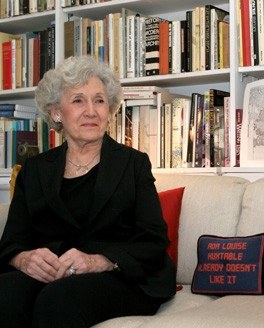Ada Louise Huxtable, Doyenne of Architecture Criticism, Dies at 91

The world of architecture is in mourning.
Ada Louise Huxtable, the Pulitzer Prize-winning, high spirited, fiercely opinionated architecture critic, revered by architecture historians and feared by developers, was the pioneer who brought serious, informed architecture criticism to daily newspapers. Her writing was invariably erudite, lucid and witty. The few times when she graciously conversed with me, in writing or in person, I felt I as though I had been touched by royalty.
At the time of her death today at the age of 91, she was architecture critic for the Wall Street Journal. She wrote until the end with the verve, feistiness and exhaustive command of the facts of someone one-third her age.
Take her final piece for the WSJ, published early last month, about the New York Public Library’s plans to renovate and restructure its flagship 42nd Street facility (or, as she put it, “to undertake its own destruction”). She delivered a detailed analysis of why, in her estimation, the library’s stacks should not be demolished—arguing her case not just on historic preservation grounds, but also on engineering grounds:
What no one seems to have noticed, or mentioned, is that the stacks are the structural support of the reading room. They literally hold it up….Restoration and retrofitting would be easier and cheaper than supporting the reading room with the enormously complex and expensive engineering needed during demolition and reconstruction.
What’s more, she allowed herself the rare luxury of complaining in print (at some length) about the runaround she had gotten after asking library officials to release “schematic studies of how the vacated space would be used….I have been patient and cooperative, but I believe I have waited long enough.” What she didn’t mention was that her exasperation may have been heightened by a consciousness that her own time was running out.
It is probably no coincidence that two weeks after Ada Louise’s heated critique, the Library released more information about its construction plans. In her NY Times report on this, Robin Pogrebin tipped her hat to Huxtable by quoting her complaint in the the rival newspaper about the long-time dearth of information. The Library claimed that “the designs were not refined until now,” Pogrebin reported.
I hope that both the online editions of the Wall Street Journal and the New York Times (where Ada Louise wrote with universally admired distinction from 1963 to 1982) will link to highlights from among her many articles, along with an appreciative recap of her many achievements. (The Times has just posted its detailed obituary.)
The tributes from the art and architecture critics who are her progeny are already pouring in.



